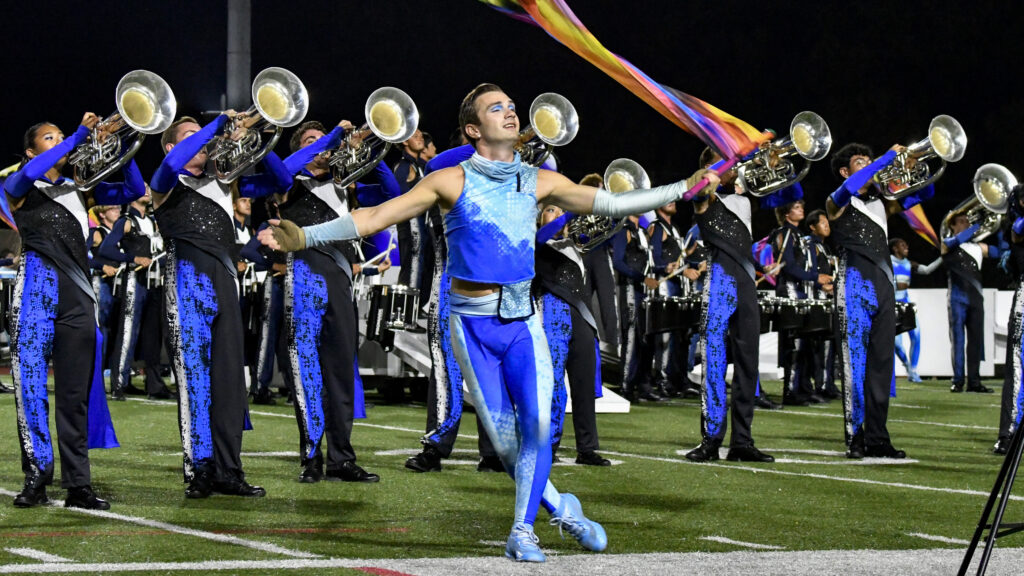
In 1989, both the DCI World Championships and Santa Clara Vanguard’s “Phantom of the Opera” returned to Kansas City for the second year, with Vanguard earning its fifth DCI title after placing 2nd the previous four years in a row and earning a record high score for the time. Madison Scouts, after winning the title in 1988, slipped to 7th place. Garfield Cadets changed their name to the Cadets of Bergen County and introduced a “strobe light” effect near the end of their “Les Miz” show, while Suncoast Sound performed a new “Florida Suite,” taking a fresh view of their all-original music show from four years earlier. Crossmen popped back into Finals for the first time since 1984, after falling to 21st place in 1986, and Freelancers returned to the Top 12 for the first time since 1985. Bloomington, Indiana’s Star of Indiana, in its fifth season, finished in the top six for the first time, moving up one position after sitting in 7th place the previous two years. The corps immersed itself in the pomp of British music, playing the music of William Walton and Gustav Holst. The color guard was divided into two groups, one as the less formal tartan-clad Highlanders, interpreting the longer arc of the lyrical moods, and the other the more prim and proper Redcoats, focused on the more concise, shorter segments of the musical lines. The two groups set up a visual counterpoint that helped the eyes “hear” the music. The production opened with William Walton’s brash “Overture: The Globe Playhouse” from “Henry V.” Walton wrote the music for a 1944 film produced near the end of World War II, directed by and staring Laurence Olivier. The film was partially paid for by the British government as a morale booster for the British people and based on the Shakespeare play of the same name. Brassy and regal, the music was visually accented by shields, coats of arms and other heraldry references in the guard. The power and articulateness of the brass was one of the highlights of the season.
Gustav Holst’s calming “Song Without Words” was conceived as mimicking the serenity of an English garden. Subtitled “I’ll Love My Love,” it was the second movement from Holst’s “Second Suite in F for Military Band,” largely based on folk tunes and published 11 years after it was written in 1911. Focused more on beauty than impact, the end of this relatively short segment, less than 90 seconds long, is where the corps’ trademark star formation appeared in the drill. Holst’s “Fantasia on the Dargason” is the final movement from “Second Suite in F” and was based on “Dargason,” a 16th Century English dance. The “Dargason” part was introduced by the tubas and largely played by the percussion, accented by butterfly flags that appeared to flutter apart from any connecting pole.

The frenetic and propulsive nature of this movement, seeming at times to be on the verge of flying right off the field, was countered by overlaying the traditional folk dance “Greensleeves.” The popular melody, which is known to many as the melody for the Christmas tune, “What Child is This?” was worked into the piece near the end and gave the piece its bedrock stability. William Walton’s regal march, “Crown Imperial,” was first performed at the coronation of Britain’s King George VI in 1937, although that was not what Walton intended when he wrote the piece. He originally wrote the work for the coronation of King Edward VIII, who infamously abdicated the throne the year prior to marry an American socialite twice divorced. The story of King George VI’s ascention to the throne was most recently detailed in the film, “The King’s Speech,” which won the Academy Award for Best Picture in 2011. The Redcoats utilized maces in the first part, which is seen in the accompanying video. This is the more lyrical introduction of the piece, almost understated compared to the far more bombastic treatment of the same melody that followed, where Walton seemed to assure the British subjects that their kingdom still ruled the waves and every other part of the known universe. The brass players really cut loose in the final segment, offering a glimpse at the power and pageantry that we would see to an unparalleled degree in the corps’ stellar production of “Belshazzar’s Feast” the next season. The 1989 season was the very middle of the corps’ all-too-short nine years on the field. It was arguably the jumping off point for Star to become a true drum corps powerhouse the following year, when the sophistication level of the corps burst wide open. From 1990 on, the corps would continue to burst through increasingly demanding levels of intellectual and artistic complexities on the field. In a sense, 1989 represented the last year that Star was the lovable newcomers, very good but arguably not yet astoundingly great. And in a way, it was also the last season that the corps threw open its arms to be hugged and adored by Joe and Jane Fans in the stands. From then on, it was all about the business of winning. For this week only, you can save on the Legacy Collection DVD that contains this complete Star of Indiana performance, along with all finalists from the 1989 DCI World Championships. Buy the 1989 Legacy Collection DVD. (Available this week only for 20% off. Regular price: $35.95.)
1989 Overview
Discount DVD offer ends Monday, May 13 at 8:30 a.m. ET.

Michael Boo was a member of the Cavaliers from 1975-1977. He has written about the drum corps activity for more than a quarter century and serves as a staff writer for various Drum Corps International projects. Boo has written for numerous other publications and has published an honors-winning book on the history of figure skating. As an accomplished composer, Boo holds a bachelor's degree in music education and a master's degree in music theory and composition. He resides in Chesterton, Ind.





